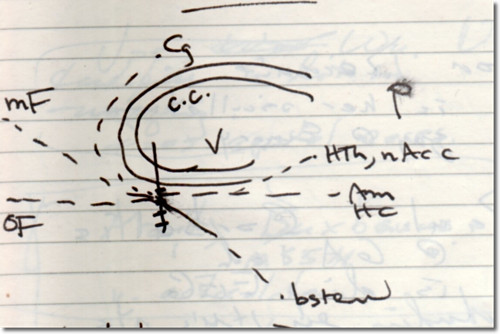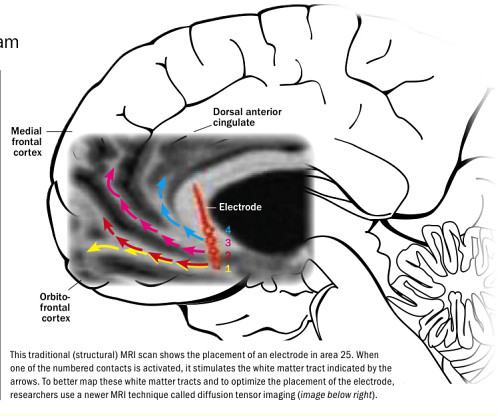I've got a story about Helen Mayberg's work on depression circuits in the new Scientific American Mind. I first wrote about Mayberg in the Times Magazine three years ago, in an article about her experimental use of deep brain stimulation to treat depression, and I later profiled her for SciAm Mind. This new article looks at her effort to further refine the neurocircuitry associated with major depression.
Working with fellow imaging experts Heidi Johansen-Berg and Tim Behrens of the University of Oxford and others, Mayberg used DTI to produce detailed images of area 25's "tractography," the layout of the white matter tracts that connect disparate brain regions.
When I talked with Mayberg about this last November at the neuroscience meeting in DC, she drew a picture in my notebook of what she'd been up to:
This is a rough-and-ugly "wiring diagram" of five key brain tracts that intersect at Area 25, the pea-sized area of the brain that Mayberg has identified as a sort of junction box that goes awry in depression.
[These five tracts carry] neural traffic among five vital areas: the amygdala, a deep-brain area that modeÂrates fear and other emotions; the orbitofrontal and medial frontal cortices, two poorly understood areas that apÂpear to be significant in expectation, reward processing, error assessment, learning and decision making; the hippocampus, vital to memory; and the hypothalamus, which helps to regulate stress and arousal.
Here'a another illo, from the story in the print version of SciAm Mind:
The refined imaging of these tracts does more than just confirm Mayberg's previous work identifying area 25 as a junction box. It also gives her a map that provides diagnostic and targeting information for DBS treatments of the area. As she expected, the locations of those tracts varies among individuals. "And this variation," Mayberg says, "along with variations in the nature of different patients' depression, probably explains why some patients respond better than others. Because the location varies, we're not hitting all five tracts the same way in every patient."
She's now doing a new, 20-patient DBS trial at Emory to to see which of the tracts seems to be most essential to the treatment's success so she can identify which patients will benefit from surgery. Eventually, as the article notes, she expects she might be able to use less intrusive and even more precise means, like fiber-optic stimulation being explored by Kark Deisseroth, to tweak the areas in question.
More reading:
- Check out the SA Mind article here.
- Mayberg's more recent articles describing this work include 2007 paper from Cerebral Cortex , a 2008 paper reporting on the original Toronto trial of DBS for depression, and a 2008 article ($) on the "receptor architecture' from Human Brain Mapping.
- Karl Deisseroth's lab page is here, and a YouTube of a lecture of his, "Controlling the Brain with Light," is here.


